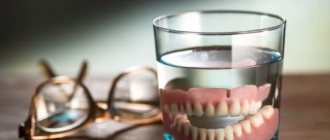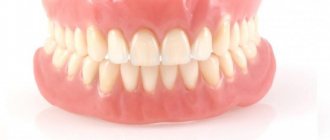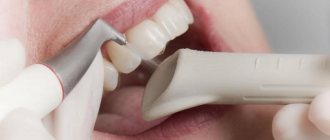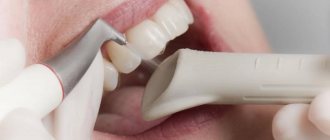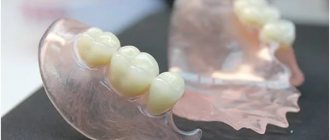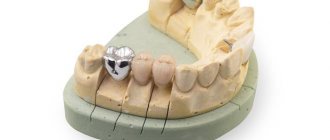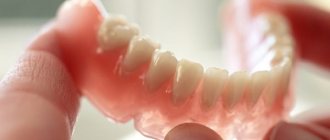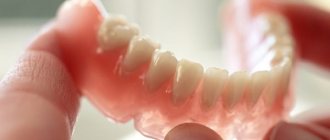From this article you will learn:
- how to care for dentures made of plastic,
- how to store dentures at night,
- cleaning dentures.
The article was written by a dentist with more than 19 years of experience.
Caring for dentures is a whole range of activities, which includes not only daily hygienic care of the denture, but also its regular disinfection, as well as compliance with the rules for its storage. In most cases, patients do not properly care for their dentures, which quickly makes them unusable.
For example, out of habit, you may begin to clean your dentures with regular toothpaste and a brush, which will lead to the appearance of small scratches on it. As a result, the surface of the denture becomes rough, which leads to the rapid deposition of plaque and tartar on it, the appearance of age spots, and the denture itself begins to smell bad. But caring for removable dentures is not so complicated - you just need to follow a few simple rules, and then your denture will serve you for a long time.
How long does it take to get used to removable dentures?
On average, 30 days. At the beginning of use, removable dentures feel like a foreign body and can cause discomfort. They can interfere with the production of sounds (diction), cause increased salivation, changes in taste and temperature sensations, and difficulty biting and chewing food. Sometimes, when applying removable dentures, the urge to vomit may occur. It is also possible that the dentures do not adhere satisfactorily, or food debris gets underneath them, or biting the cheeks, lips, or tongue. All these phenomena decrease by the end of the first week of wearing the prosthesis and disappear after 3-4 weeks. After an adaptation period, the patient already feels more comfortable with prostheses than without them.
The main condition for quickly getting used to prostheses is their constant use. The rules and recommendations below will help you shorten the adaptation period.
How to quickly get used to new dentures
- Immediately after submitting the finished work in the dentist’s chair, learn how to remove and put on removable dentures yourself. At home, practice again, first in front of a mirror, then without it.
- Before applying, soak removable dentures in water or use a fixative.
- For the first one and a half to two weeks after the application of dentures, they should not be removed from the mouth, even at night. Take them out only for cleaning and oral hygiene.
- To reduce the gag reflex, try sucking the candy by placing it towards the roof of your mouth and holding it in this position with your tongue.
- Rinse your mouth often with warm water (8-10 times a day) or drink hot tea.
- Reading aloud in a calm, relaxed atmosphere for 2 hours helps to quickly restore correct pronunciation. In most patients, diction is restored quite quickly (after 5-6 days)
- For the first 2-4 days of wearing the prosthesis, try to eat soft foods and not load the prosthesis until you fully adapt to it. Try not to bite with your front teeth. Chew your food slowly and thoroughly.
- Chew food with your side teeth at the same time (left and right at once). Cut food into small pieces. Introduce more fruits and vegetables into your diet (this will allow you to switch to your usual diet earlier).
What are the main rules when using removable dentures?
Dentures must be clean. After each meal, they should be removed from the mouth and washed thoroughly with soap and water.
Removable dentures should be protected from mechanical and chemical damage, as well as from exposure to high temperatures. If cracks or breakages appear in a removable denture, you cannot use it; you must consult a doctor for repairs.
Do not take breaks from wearing a prosthesis for more than one and a half to two weeks, because... this can lead to an initial discomfort that can make it difficult to fit the prosthesis exactly into place. As a rule, if a prosthesis is not used for more than a month, it becomes unusable and a new one needs to be made.
Rules of care
Features of hygiene and care of the structure depend on whether you use a cream to fix the prosthesis. Its use allows solving two problems at once: improving the “adhesion” of the structure to tissues, as well as reducing the ingress of food particles under the prosthesis. That is why patients who use such a cream can remove the denture not every time after eating, but once a day.
The general rules for caring for removable dentures are:
- Rinsing the denture after eating - remove the structure and rinse it under running water, removing any remaining food. Be careful - accidentally dropping the prosthesis may cause it to break. It is better to do this over a sink - the likelihood of breakage if dropped is much lower than when washing over a bathtub.
- If your natural teeth are intact, it is important to brush them after eating using a soft toothbrush and toothpaste. Pay attention to your tongue and palate. If your teeth are missing, use a soft gauze swab soaked in mouthwash.
- Caring for removable dentures at home involves cleaning the structure - 2 times a day (morning and evening), thoroughly clean it of dental plaque and the smallest food debris using a soft toothbrush.
It is important to thoroughly clean those parts of the denture that are adjacent to the gums. This is due to their direct contact with soft tissues - careful treatment will avoid inflammatory diseases.
Pay special attention to whether you are bending the metal clasps or the plastic of the prosthesis - you should not do this.
To clean the prosthesis, it is better to choose a low-abrasive paste - a regular one can cause small scratches on the surface of the prosthesis. When buying paste, pay attention to the abrasiveness rating on the package (RDA). Conventional toothpastes have a value of about 60. Children's toothpastes have the lowest abrasiveness. Give preference to products with a value from 0 to 25. In extreme cases, you can use liquid soap, thoroughly rinsing the denture after cleaning.
Choosing the right toothbrush is no less important. Avoid brushes with stiff bristles. It is allowed to use brushes only with soft bristles (marked “soft”).
What is prosthesis correction and when should it be done?
After applying removable dentures in the oral cavity, as a rule, pain appears in some areas underneath. This is due to the inevitable gradual subsidence (pressure) of the removable denture on the mucous membrane. This factor cannot be fully taken into account when designing these orthopedic structures, therefore, correction is necessary to eliminate unpleasant sensations. It consists of “undermining” the dentures in those areas where it presses on the oral mucosa.
The first correction must be carried out the next day after the start of using dentures. The next 3-4 corrections must be carried out over a period of one and a half to two weeks as necessary. You may need more visits to the dentist after completing your work (up to 10).
In case of severe pain, you need to remove your dentures and put them in a special container or glass of water. Before going to the doctor for correction, you must wear dentures and walk around with them for at least 3-4 hours. This will allow the doctor to see a clear imprint on the mucous membrane and correct only the place that is rubbing the gum. Bringing a denture in your pocket and pointing your finger in your mouth is useless. In removable dentures, every centimeter, and sometimes even a millimeter, of the supporting surface is of great importance. If the correction is inaccurate, the fixation of the prosthesis may be impaired. This is exactly what happens if you try to grind or file dentures yourself. After correction (adjustment) of removable dentures, you must not use them for 1 day. During this period (during the healing period of the namin), it is advisable to rinse your mouth and make baths (hold the solution in the mouth at the site of the namin) with herbal decoctions. Use a decoction of chamomile flowers, oak bark, etc. For example, take 0.5 tablespoons of dry oak bark, brew in one glass of boiling water, cool, apply the decoction 3-5 times a day. You can also use medicines, for example Kamistad gel, sold in pharmacies.
Feel free to visit your dentist for adjustments. Removable dentures, even if they are made in the most careful manner, require correction. Even if you do not experience any pain or discomfort, you should visit the dentist for an oral examination.
WARNING : Do not attempt to straighten dentures yourself with a file or any other tool. This can lead to breakage of the prosthesis and disruption of its fixation. Moreover, after such “repairs” it is no longer possible to do anything with the prostheses in the clinic. As a result, all that remains is the manufacture of new orthopedic structures.
Is it worth using folk remedies?
Often people, in search of what to clean and how to whiten dentures[1] made of plastic, acrylic, nylon at home, decide that nothing can be better than folk remedies. Acetic acid, salt, activated carbon, tooth powder, soda, peroxide, citric acid and even a microwave are used. But, according to experts, careless and improper use can cause irreparable harm to artificial teeth (and natural ones too), gums, and fastening elements. The orthopedic structure may crack or become stained. Therefore, the choice between improvised folk remedies and pharmaceutical drugs with carefully selected composition should still be inclined in favor of the latter.
Citrus juices and citric acid
How to clean dentures with citric acid? To do this, take citric acid on the tip of a knife and mix with 1-2 peas of toothpaste or a small amount of tooth powder. Citric acid can be replaced with 1 teaspoon of freshly squeezed lemon or orange juice. Then apply the mixture with a brush to the product and leave for 15-20 minutes. Then clean it with a brush and rinse in running water.
Baking soda and hydrogen peroxide
For this method, you should take 1-2 teaspoons of soda (baking soda only), a little water and hydrogen peroxide - literally a few drops each. Gradually add the liquid to the soda and mix to form a slurry - then it is applied to the structure with a brush and cleaned. The method may help whiten dark plaque, but large particles of baking soda powder will leave scratches on the product.
How to care for removable dentures
Proper care of them is of great importance for the period of adaptation (adaptation) and the service life of prostheses. Removable dentures require regular cleaning. The best option is to clean dentures daily after each meal under running water. The obligatory minimum is cleaning the prosthesis before going to bed. The main criterion is that the prosthesis must be as clean as on the first day. The cleaner the denture, the more comfortable you will feel it in your mouth.
When cleaning a denture with whitening toothpaste, scratches may form on it, which contributes to the rapid accumulation of plaque on the denture, because Such pastes contain abrasive substances, so for daily care you can use a weak soap solution.
Dirty removable dentures cause rapid wear and tear and inflammation in the oral cavity. If there is inflammation of the mucous membrane in places of contact with a removable denture, pain, or burning, you should immediately consult a doctor. From strong tea, coffee and smoking, removable dentures lose their appearance, turn yellow, and a brown coating appears on them. With good care, removable dentures retain their color and shine for a long time.
An indicator of good care is the absence of food and plaque on the prosthesis. To remove age spots from coffee and nicotine, etc., which may appear over time, you should consult a doctor. The dental technician will restore the necessary polish and shine.
To clean dentures, you can use special cleaning agents sold in pharmacies (President, Corega, Protefix). They also help get rid of plaque and destroy bacteria that cause bad breath. The prosthesis is placed in a glass of clean water and a tablet is lowered; the prosthesis is kept in the solution for a certain time recommended by the manufacturer.
Cleaning the prosthesis from heavy dirt –
By severe contamination we mean pronounced pigment plaque, or partially mineralized microbial plaque, or already hard tartar. Such tightly attached dental deposits can be removed from the surface of a removable denture in 2 ways. Firstly, use a special ultrasonic bath (this is not only very convenient, but will also allow you to save on purchasing effervescent tablets in the future). But there is another option, which we will discuss below.
1) Using an ultrasonic bath –
The best care for removable dentures can be achieved using an ultrasonic bath (Fig. 5). This bath allows you to ideally clean the denture from tartar, pigment plaque and odor, and also kills 100% of bacteria. In addition, you will no longer need to buy any chemicals (and spend money on it), or scrub the denture with a toothbrush.
The cost of an ultrasonic bath for cleaning dentures is only from 2500 to 3500 rubles. Such a device for cleaning dentures can also be used for contactless cleaning and disinfection of items for any other purpose, for example, baby items (pacifiers, bottles), precious metals, and other items. Of course, on the Internet you can find Chinese models for 500 rubles, but they all have low power (cleaning will be weak) and are not very reliable.
The most important criterion that will allow you to compare ultrasonic baths from different manufacturers and choose the best one is the power of the ultrasonic waves (measured in W). This indicator is usually always written in the product characteristics. Accordingly, the quality of cleaning the prosthesis will depend on the power.
2) The most powerful denture cleaner –
This option for cleaning the prosthesis can only be considered as an emergency assistance, without resorting to it too often. This method will allow you to efficiently remove all dental plaque and pigment plaque, and it is often used in hospitals to clean removable dentures in bedridden patients. Please note that this cleaning option is suitable for all types of plastic dentures (including nylon and Acry-free), but is NOT suitable for dentures with metal structural elements.
To do this, you need to purchase a descaling liquid for coffee machines. Why in coffee machines: we believe that such liquids make them better and safer, because... Coffee machines are complex, expensive devices that also contain plastic parts. And manufacturers produce anti-scale liquids for their coffee machines, guaranteeing that they will not harm either their devices or those who drink coffee. We experimented with De'Longhi EcoDecalk descaler, which, according to the instructions, is diluted with lukewarm water - 1:10.
De'Longhi EcoDecalk (500 ml) –
Those. The product is quite economical, and you can buy it cheapest on Ozon or Yandex Market (sold in 250 or 500 ml volumes). The denture can be soaked in a diluted liquid for 10-20 minutes, then rub the denture a little with a soft brush and then rinse well with running water. But if you have a thick layer of plaque or dental deposits on your denture, then you can safely leave the denture in the solution for several hours. Our experience has shown that thanks to this treatment, the denture can be cleaned even from massive plaque and dental deposits. And let us warn you once again - this option is only suitable for prostheses that do not have metal structural elements.
How to improve the fixation of removable dentures
The anatomical conditions in the oral cavity do not always allow for the creation of good fixation for removable dentures. This especially applies to prosthetics for the complete absence of teeth in the lower jaw. Under unfavorable conditions, special fixing agents in the form of creams, fixing pads, and powders are used to keep it in the mouth. They are sold under the brands “President”, “Corega”, “Protefix” in any pharmacy.
The fixing cream is applied in a thin broken line to the prosthesis. Before applying the cream, removable dentures must be dried, for example with a cotton swab. Fixing powder is used for low salivation. It is applied in a thin layer to the wet denture, after which the removable dentures can be put on. Your dentist will help you decide on the choice of fixative.
Frequently asked questions from users
Question from Tatyana R.: Hello, is it possible to whiten dentures with whitening strips? I have clasps, and my teeth are darkened on them, and the toothpastes don’t help at all.
ANSWER: Hello, Tatyana. Using whitening strips, you can seriously harm your supporting teeth and gums if the active gel from them penetrates under the denture. Even if there is a microscopic gap between the hooks or attachments and the gum, this is quite likely. If you whiten the denture in strips after removing it from your mouth, this is also not the best solution - stains and cracks may appear on the base and teeth. To clean orthopedic structures, it is better to contact dentistry. The doctor will assess the condition of the dentures, clean and polish them using professional methods. But if the pigmentation has penetrated very deeply into the coating, repair or replacement of the prosthesis may be required.
[1] Lebedenko I.Yu. Prosthetic dentistry: national guidelines, 2022.
Author: Dulgarov Zh. G. (Thank you for your help in writing the article and the information provided)
What to do if your prosthesis breaks?
During the use of removable dentures, a fracture of the prosthesis or its individual parts (tooth, clasp) may occur. In this case, you need to consult a dentist. If a tooth(s) on which partial removable dentures are held or supported are lost, it is possible to weld an artificial tooth to the denture in place of the lost one. Repairing a removable denture takes 2-3 days. Repairs are made without warranty.
In case of cracks, fractures, etc. Do not try to fix the denture yourself, even if urgently. Only specialists can repair the prosthesis.
Making new removable dentures takes about 1 week. The warranty period for plastic removable and clasp dentures is usually up to 1 year. During the warranty period, the prosthesis is repaired or altered free of charge. After the warranty period expires, the work is paid in full.
Side effects due to unsuitable whitening products
Side effects from the wrong selection of cleaning or bleaching agents can damage the prosthetic structure to such an extent that it loses its attractive appearance and functionality. Consider the dangerous consequences:
- the appearance of scratches and cracks on the product,
- the appearance of white, colored or dark spots on artificial teeth, gums, metal components,
- unpleasant taste or burning in the mouth,
- allergic reactions, stomatitis,
- displacement or breakage of clasps,
- deformation and destruction of the orthopedic structure.
“I’m already used to using cleaning tablets - it’s convenient and the results from them are noticeable. The paste didn't help much. And I soak the plastic in the solution a couple of times a week and everything is fine. I've been using it for 2 years now and it looks just like my teeth. But I also go to the dentist for professional cleaning, otherwise I can’t remove the stone with a simple brush.”
Irina P., review from gidpozubam.ru
In what cases is it necessary to contact a dentist?
If you notice a burning sensation in the mucous membrane, severe dry mouth, skin rash and other unusual symptoms, you should contact your dentist, who, if necessary, will refer you to an allergist for allergy tests.
Once a year it is necessary to reline the removable denture. The fact is that while wearing a prosthesis, atrophy of the mucous membrane and bone tissue occurs under it. Because of this, a void appears between the prosthesis and the mucous membrane and the prosthesis does not fit tightly to the prosthetic bed. To eliminate these negative aspects, the prosthesis is relined - plastic is placed in place of the void formed due to atrophy and a tight fit of the prosthesis is restored. If relining a removable denture is done at the wrong time or not done at all, the removable denture becomes unusable.
Visit your dentist at least twice a year, consult with him about the specifics of caring for your oral cavity, and use special devices and medications recommended by him, if necessary!
Disinfection of the prosthesis
From time to time, dentures should be disinfected, which will clean the surface of harmful bacteria. You can do this in two ways:
- Using disinfectants - special effervescent tablets that are pre-dissolved in water. Such preparations contain substances that help dissolve dental plaque, destroy bacteria and additionally whiten structures. When using tablets, just put the prosthesis in the prepared solution and wait 3 minutes. If necessary, at the end of the procedure, you can use a toothbrush and remove any remaining plaque manually.
- In an ultrasonic bath, the device helps remove bacterial plaque, get rid of unpleasant odors and destroy up to 100% of pathogens. The bath is more expensive than disinfectants, but you can buy it once and no longer spend money on purchasing chemicals.

